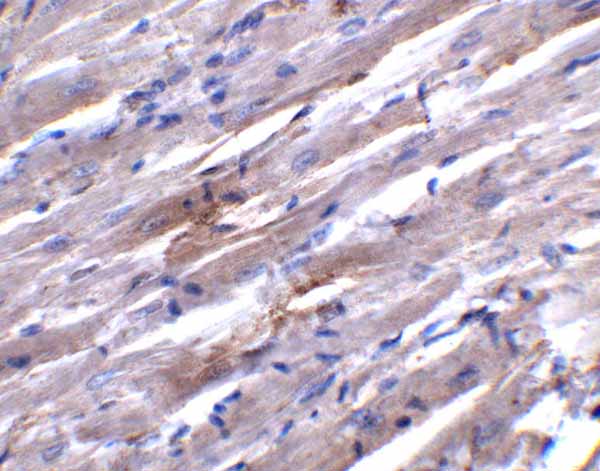IL-11 Antibody
- SPECIFICATION
- CITATIONS
- PROTOCOLS
- BACKGROUND

Application
| WB, IF, ICC, E |
|---|---|
| Primary Accession | P20809 |
| Other Accession | NP_000632, 3589 |
| Reactivity | Human |
| Host | Rabbit |
| Clonality | Polyclonal |
| Isotype | IgG |
| Calculated MW | Predicted: 20 kDa Observed: 19 kDa |
| Application Notes | IL-11 antibody can be used for the detection of IL-11 by Western blot at 1 - 2 μg/mL. Antibody can also be used for immunocytochemistry at 10 μg/ml. |
| Gene ID | 3589 |
|---|---|
| Target/Specificity | IL-11 antibody was raised against a 16 amino acid peptide from near the amino terminus of human IL-11. The immunogen is located within amino acids 40 - 90 of IL-11. |
| Reconstitution & Storage | IL-11 antibody can be stored at 4℃ for three months and -20℃, stable for up to one year. |
| Precautions | IL-11 Antibody is for research use only and not for use in diagnostic or therapeutic procedures. |
| Name | IL11 (HGNC:5966) |
|---|---|
| Function | Cytokine that stimulates the proliferation of hematopoietic stem cells and megakaryocyte progenitor cells and induces megakaryocyte maturation resulting in increased platelet production (PubMed:2145578). Also promotes the proliferation of hepatocytes in response to liver damage. Binding to its receptor formed by IL6ST and IL11RA activates a signaling cascade that promotes cell proliferation (PubMed:12919066). Signaling leads to the activation of intracellular protein kinases and the phosphorylation of STAT3. The interaction with the membrane-bound IL11RA and IL6ST stimulates 'classic signaling', whereas the binding of IL11 and soluble IL11RA to IL6ST stimulates 'trans-signaling' (PubMed:30279168). |
| Cellular Location | Secreted |

Thousands of laboratories across the world have published research that depended on the performance of antibodies from Abcepta to advance their research. Check out links to articles that cite our products in major peer-reviewed journals, organized by research category.
info@abcepta.com, and receive a free "I Love Antibodies" mug.
Provided below are standard protocols that you may find useful for product applications.
Background
Interleukin 11 is a pleiotropic cytokine that has multiple effects on both hematopoietic and nonhematopoietic cells. Many of the biological effects described for IL-11 overlap those for IL-6 (1). It directly stimulates the proliferation of hematopoietic stem cells and megakaryocyte progenitor cells and induces megakaryocyte maturation resulting in increased platelet production (2). IL-11 promotes the proliferation of hepatocytes in response to liver damage. IL-11 binds to its receptor formed by IL6ST and either IL11RA1 or IL11RA2 (3). Clinically it is used to prevent severe thrombocytopenia and the reduction of the need for platelet transfusion following myelo-suppressive chemotherapy (4).
References
Paul SR, Bennett F, Calvetti JA. Molecular cloning of a cDNA encoding interleukin-11, astromal cell-derived lymphopoietic and hematopoietic cytokine. Proc. Natl. Acad. Sci. USA 1990; 87:7512-6.
Yang YC and Yin T. Interleukin (IL)-11 mediated signal transduction. Ann. N.Y. Acad. Sci. 1995; 762:31-40.
Dimitriadis E, Robb L, Salamonsen LA. Interleukin 11 advances progesterone-induced decidualization of human endometrial stromal cells. Mol. Hum. Reprod. 2002; 8:636-43.
Andersson By U, Tani E, Andersson U. Tumor necrosis factor, interleukin 11, and leukemia inhibitory factor produced by Langerhans cells in Langerhans cell histiocytosis. J. Pediatr. Hematol. Oncol. 2004; 26:706-11.
If you have used an Abcepta product and would like to share how it has performed, please click on the "Submit Review" button and provide the requested information. Our staff will examine and post your review and contact you if needed.
If you have any additional inquiries please email technical services at tech@abcepta.com.













 Foundational characteristics of cancer include proliferation, angiogenesis, migration, evasion of apoptosis, and cellular immortality. Find key markers for these cellular processes and antibodies to detect them.
Foundational characteristics of cancer include proliferation, angiogenesis, migration, evasion of apoptosis, and cellular immortality. Find key markers for these cellular processes and antibodies to detect them. The SUMOplot™ Analysis Program predicts and scores sumoylation sites in your protein. SUMOylation is a post-translational modification involved in various cellular processes, such as nuclear-cytosolic transport, transcriptional regulation, apoptosis, protein stability, response to stress, and progression through the cell cycle.
The SUMOplot™ Analysis Program predicts and scores sumoylation sites in your protein. SUMOylation is a post-translational modification involved in various cellular processes, such as nuclear-cytosolic transport, transcriptional regulation, apoptosis, protein stability, response to stress, and progression through the cell cycle. The Autophagy Receptor Motif Plotter predicts and scores autophagy receptor binding sites in your protein. Identifying proteins connected to this pathway is critical to understanding the role of autophagy in physiological as well as pathological processes such as development, differentiation, neurodegenerative diseases, stress, infection, and cancer.
The Autophagy Receptor Motif Plotter predicts and scores autophagy receptor binding sites in your protein. Identifying proteins connected to this pathway is critical to understanding the role of autophagy in physiological as well as pathological processes such as development, differentiation, neurodegenerative diseases, stress, infection, and cancer.


